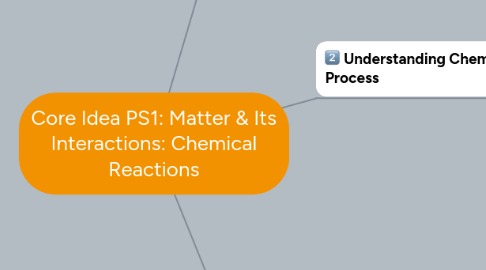
1. Understanding Chemical Process
1.1. Collision Theory
1.1.1. Qualitative model for explaining the rates of chemical reactions
1.1.2. Higher rates take place at higher temperatures because atoms are moving faster equaling more collisions
1.1.3. Chemical composition in a steady state may produce chemical reactions that are balanced with reactions in opposite directions proceeding at equal rates
1.2. Chemical Process
1.2.1. Change in chemical bonds and the related bond energies=different chemical binding energy
1.2.2. Change is matched by a difference between the total kinetic energy of the set of reactant molecules before the collision & that of the set of product molecules after the collision (conservation of energy)
1.2.3. Some reactions release energy (burning fuel in the presence of oxygen)
1.2.4. Other reactions require energy input (synthesis of sugars from carbon dioxide and water)
1.3. Understanding chemical reactions and elements is important in physical, earth, life and space sciences
1.3.1. Schedule Quality Review Meeting
1.3.2. Prepare for Quality Review Meeting
1.3.3. Conduct Quality Review Meeting
1.3.4. Follow-up Quality Review Meeting
1.4. Cycling of matter and transfers of energy depend of physical and chemical processes
1.4.1. Update Project Schedule
1.4.2. Update Budget / Costs
1.4.3. Conduct Team Status Review
1.4.4. Create Status Report
1.5. Capacity of carbon atoms to form backbone of extended molecular structures is essential to the chemistry of life
1.5.1. Carbon cycle
1.5.2. transfer between carbon in atmosphere-in form on carbon dioxide-and carbon in living matter of formerly living matter
1.6. Proportion of oxygen molecules (O2) in atmosphere also changes in this cycle
1.6.1. Identify Project Issues
1.6.2. Assess Impact of Issues
1.6.3. Assign Resources
1.6.4. Resolve Issue
2. Substances
2.1. substance+other substance=new substance with different properties
2.1.1. Recruit Project Sponsor
2.1.2. Recruit Project Manager
2.1.3. Review Related Projects and Lessons Learned
2.1.4. Prepare Project Initiation Plan
2.1.5. Brief the Initial Project Team
2.1.6. Review Project Kick-off Plans and Presentation Map
2.1.7. Hold Project Kick-off Meeting
2.2. Change in properties
2.2.1. Establish Project Objective
2.2.2. Establish Project Scope
2.2.3. Map Requirements
2.2.4. Map Solution
2.2.5. Map Training Requirement
2.2.6. Review Project Scope
2.3. Atoms in original substance are combined and rearranged in the new substance
2.3.1. Determine Project Approach, Stages and Steps
2.3.2. Estimate Project Duration
2.3.3. Establish Resource Requirements
2.3.4. Prepare Project Schedule and Budget
2.3.5. Prepare Work breakdown structure
2.3.6. Document Success Criteria
2.3.7. Review Project Schedule
2.4. # of each type of atom and mass does not change
2.4.1. Identify Project Resources
2.4.2. Recruit Project Steering Committee
2.4.3. Recruit Project Coordinators
2.4.4. Identify / Recruit Key Stakeholders
2.4.5. Determine Training Requirements
2.4.6. Map the Project Organization Chart
2.4.7. Review Project Organization
2.5. to predict the outcome of reaction one can look at the property of conservation along with the knowledge of the chemical properties
2.5.1. Establish Project Administration Procedures
2.5.2. Establish Quality Control Procedures
2.5.3. Establish Progress Control Procedures
2.5.4. Establish Change Control Procedures
2.5.5. Establish Issue Resolution Procedure
2.5.6. Review Project Control Procedures
3. Grade Band Endpoints
3.1. By the end of each grade a student should be knowledgable of....
3.1.1. Grade 2: Heating and cooling and how a substance can change. Some of these changes are reversible (melting and freezing), and sometimes they are not (baking a cake, burning fuel).
3.1.2. Grade 5: When 2 or more substances are mixed, a new substance is formed. This substance has different properties, however it depends on the substance and temperature. No matter what reaction the total weight of the substance does not change.
3.1.3. Grade 8: Substances react chemically in characteristic ways. Atoms in original substance are regrouped into different molecules and these have different properties. Total number of each type of atom is conserved and the mass does not change. Some chemical reactions release energy while others store energy.
3.1.4. Grade 12: Students understand chemical processes, their rates, and whether or not energy is stored or released. Students can describe or predict chemical reactions.
